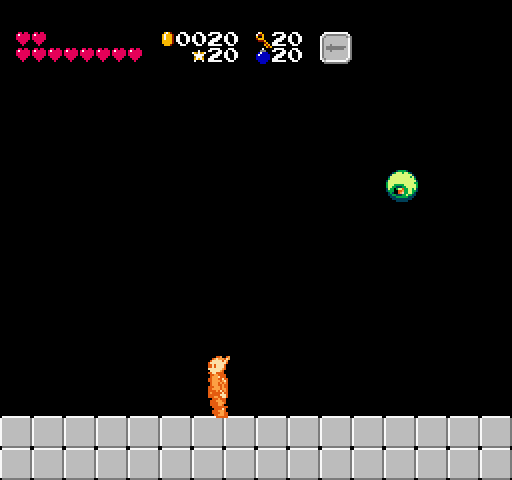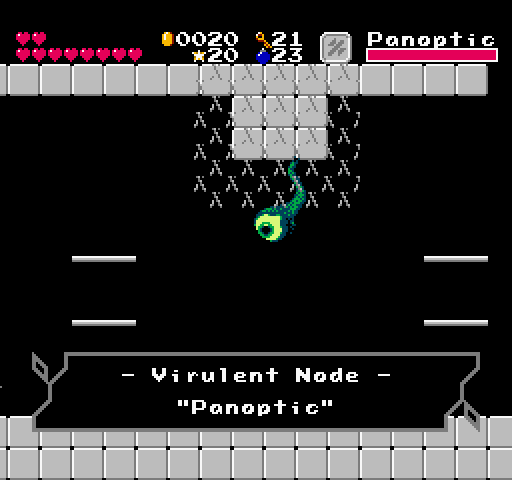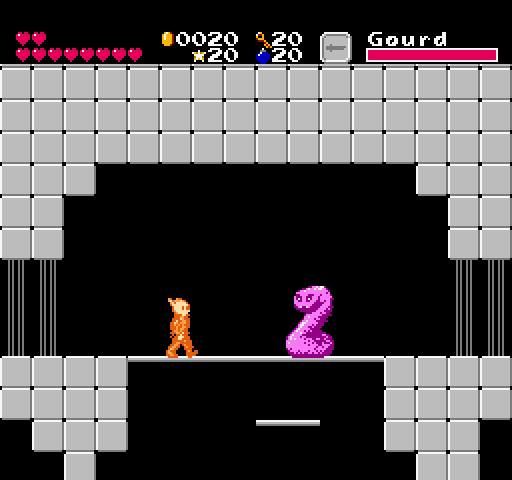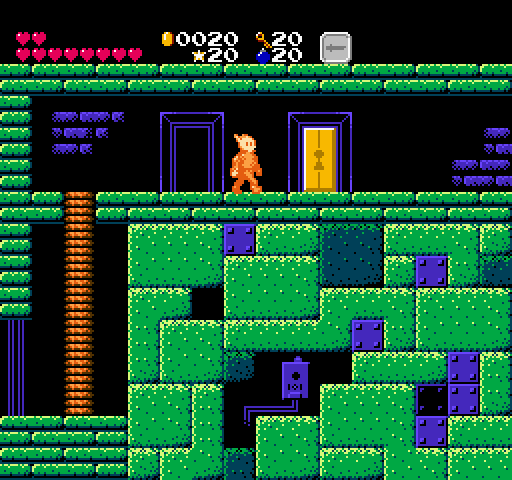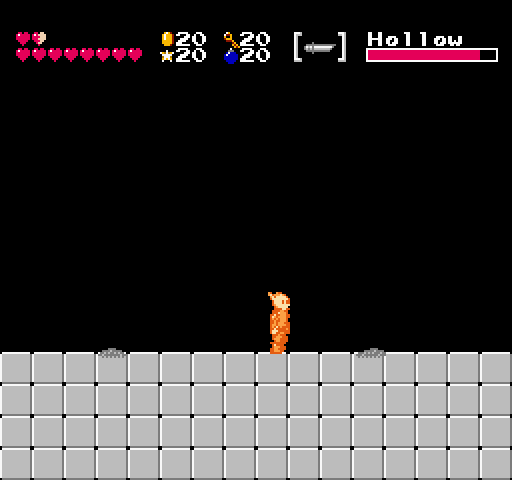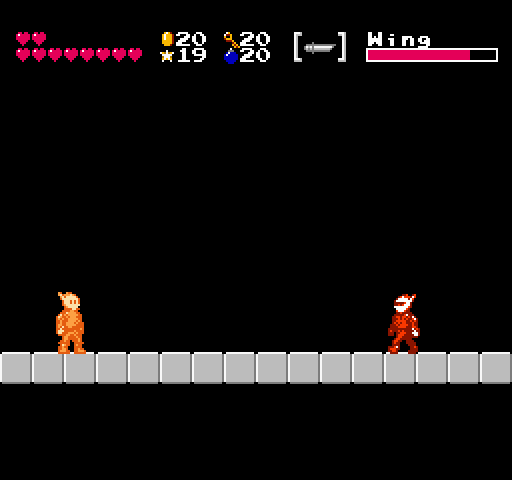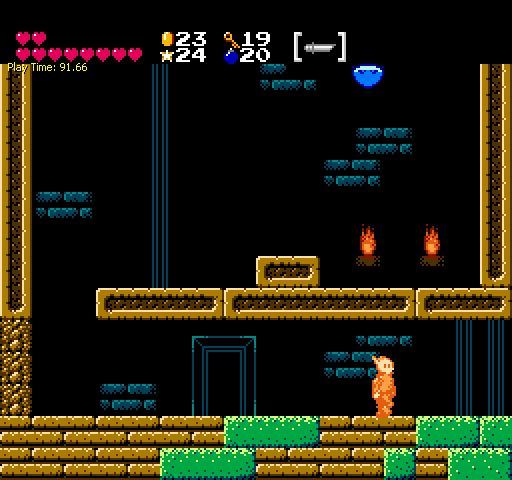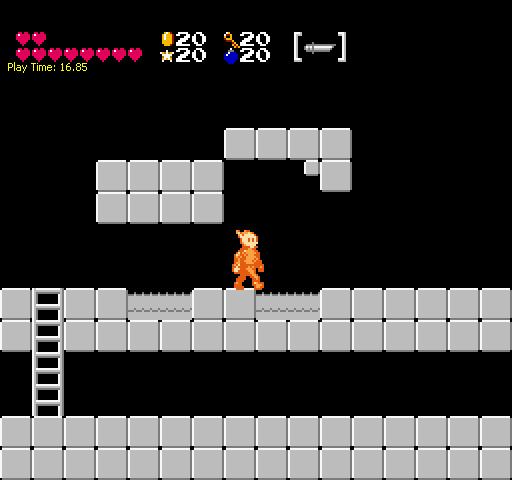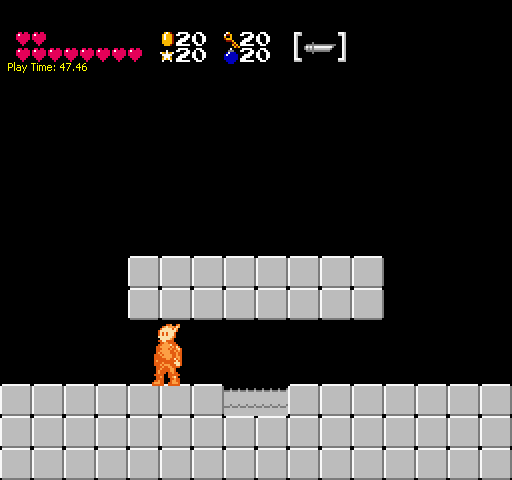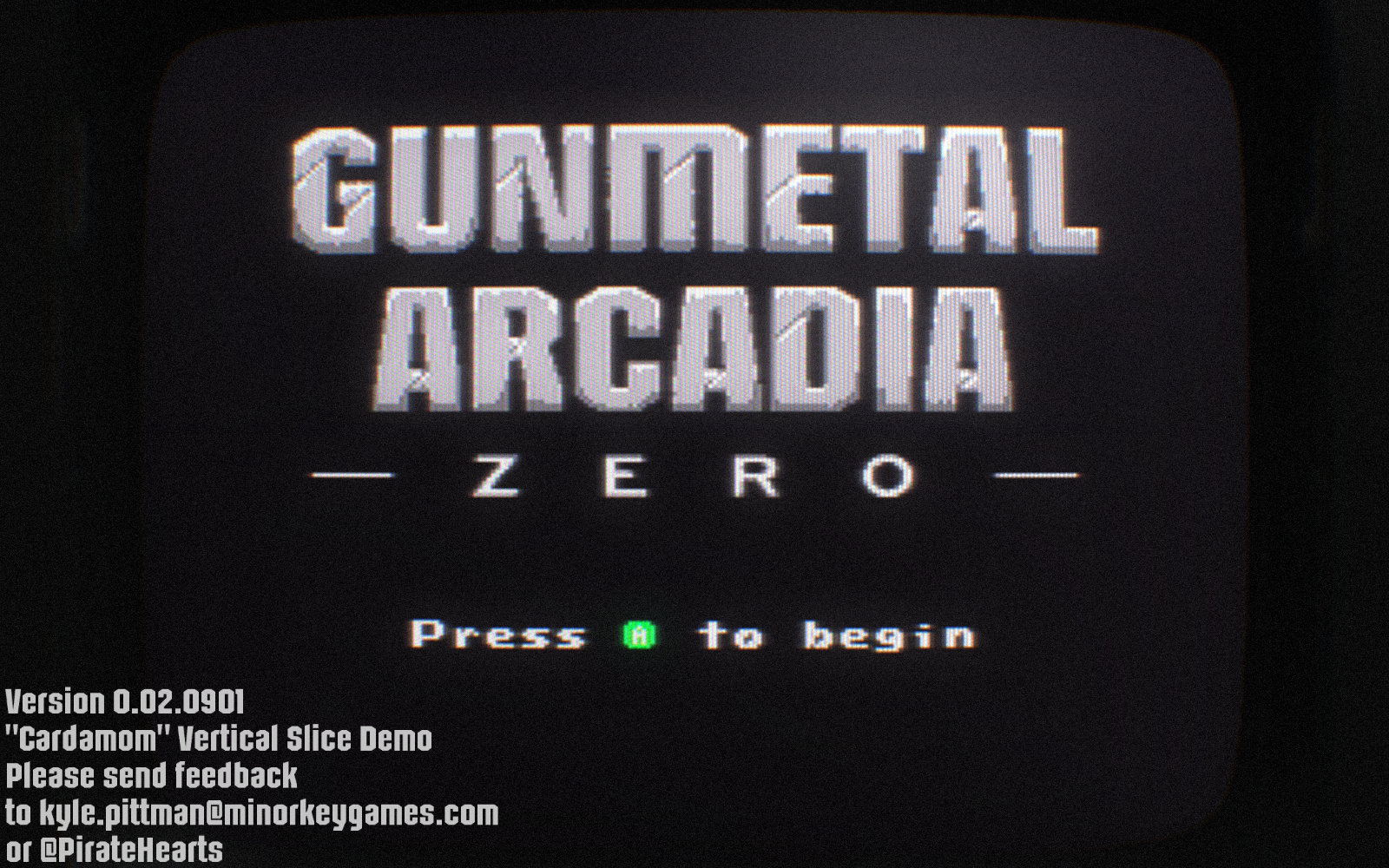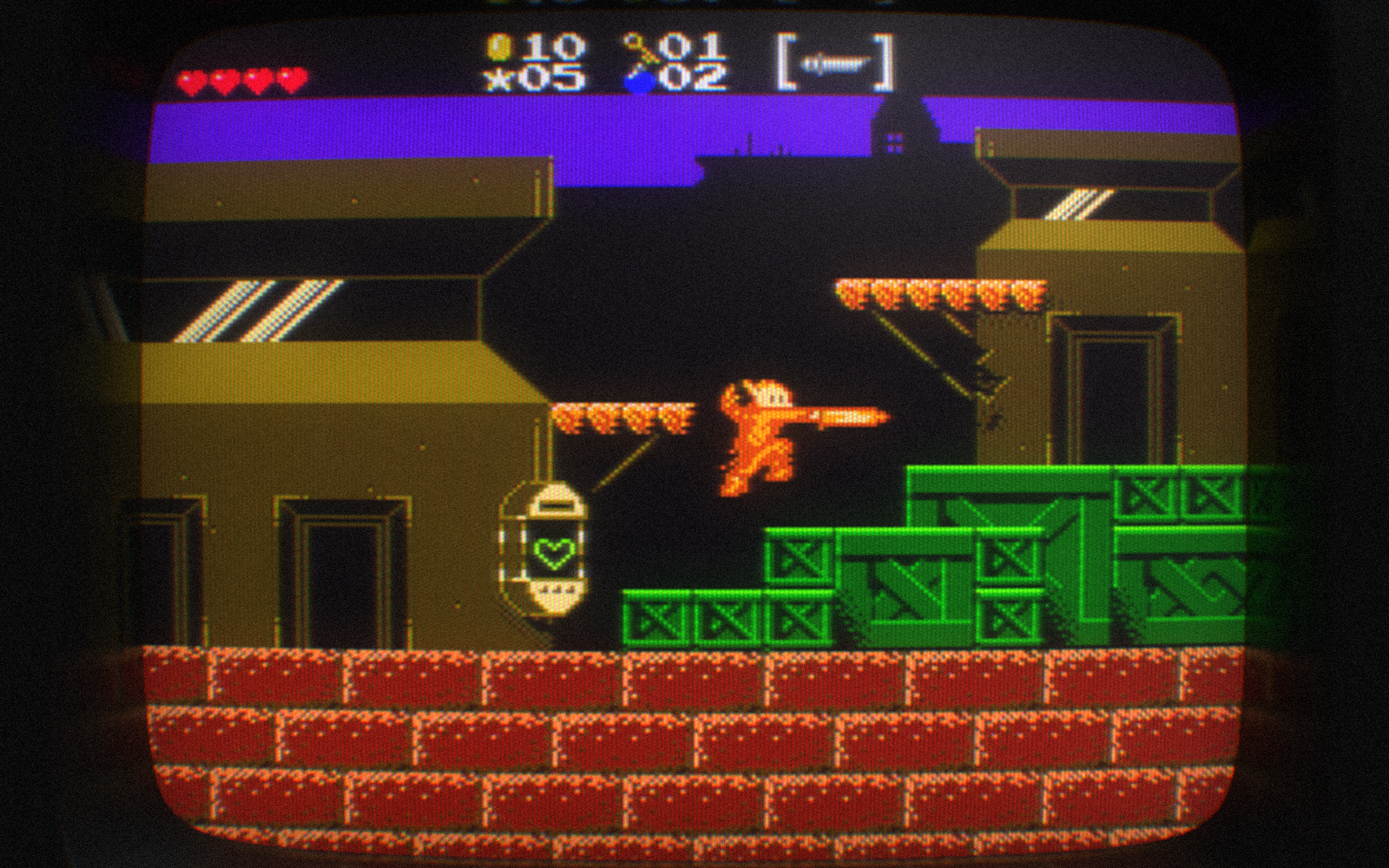I spent most of last week working on a new shopping interface, but I’m saving that one for Wednesday’s video because it works better in that format. Instead, this week I’ll be looking at a handful of ongoing changes to the game in the context of a shifting schedule. That’s right, it’s Grab Bag Time!
Let’s start with the GIF-able stuff.
I posted this one on Twitter a couple days ago. I had been toying with the concept of homing projectiles for a miniboss in a slightly different context (detailed below), and I thought it would be interesting to see how they worked in a more typical case of aimed shots fired at the player. The big takeaway was that it was frustrating to not be able to destroy them, so I added that option. They can still be a little overwhelming when there’s more than one or two of them on screen, so this is something I’ll have to use sparingly, but it’s a nice unexpected addition to my toolbox.
This is the boss of “Basil,” which is the…fooouuurth level, maybe? Maybe the third. Almost certainly one of the wilderness levels, in any case. The concept for this boss was, “How do I make an immobile turret challenging?” My solution was to give it aimed shots, place it out of reach of many attacks, and throw in some additional enemy spawners as a distraction.
This is the miniboss of the same level. It’s a pair of enemies, tentatively titled “Gourd” and “Grail.” Gourd is large and moves quickly but has no ranged attack and is fairly harmless alone, while Grail flies around and fires projectiles at its companion. These projectiles harm Vireo on touch, but they fully heal Gourd if they reach him, so Grail must be dealt with first.
As with most of my minibosses, I’m imagining these guys will make additional appearances later in the game, perhaps in scenarios that alter the dynamic with different environmental hazards and such.
Hey, remember this room from the vertical slice build? It previously contained another “Parity” who would drop a chest when he died. That wasn’t really what I wanted, but it wasn’t until just a day or two ago that I finally added support for a feature I was intending to showcase here: lock-in rooms.
This is an idea I’ve blatantly lifted from the likes of Wonder Boy in Monster Land. Every door in the background presents an opportunity for risk and reward. Some of these might be item shops, some might be optional platforming challenges to reach some desirable loot, and some of them will lock you in and make you fight monsters. There will be a reward for clearing these rooms proportional to the challenge, but when you’re running low on health or lives, I want there to be some tension in deciding whether it’s worth the risk to see what’s behind a door.
That dynamic is one that I’m especially excited to see take shape in the roguelike Gunmetal Arcadia, once levels are randomized and the contents of a door can’t be learned and known in advance. But for at least a first playthrough, hopefully it will be an interesting and exciting element of Gunmetal Arcadia Zero as well.
Keen-eyed readers may have spotted some small changes to the HUD this week. I’ve updated the art for subweapons and removed the square brackets around this icon, which in turn cleared up space to expand the money counter to four digits. So let’s talk about that.
When I started laying out the HUD and choosing resource caps, I was looking at Binding of Isaac primarily. Isaac caps money at 99, but that cap is rarely reached. A standard item costs 15 coins by default, and in many runs, that price is high enough to give pause before making a purchase. Coins are few and far between, and it can be tempting to spend them on consumables and recovery items.
That balance works well for Isaac, but unfortunately, it necessarily precludes something that I love about Castlevania games and want to integrate into Gunmetal Arcadia, and that is the notion that everything drops items all the time. In Castlevania, virtually every torch or sconce can be destroyed, and most of these drop money. In Symphony of the Night and its derivatives, these return every time a room is revisited (along with enemies), guaranteeing an endless supply of things to attack. Part of the reason SotN works as well as it does is that it’s fun to simply move through the world, jumping and hitting things, and this feature provides an incentive to do so. And yet it’s not really practical to grind for money by repeatedly reentering rooms and breaking the same torches over and over, because on repeat visits, they will only drop small amounts of ammo or coins worth a single gold. (For comparison, a single potion costs 800 gold.) But the value isn’t what really matters in this case, it’s the experience of hitting something, getting the feedback of seeing it be destroyed and drop an item, and then collecting that item. That’s where the fun is.
All of that is to say that I was having trouble reconciling the desire to drop loot all over the place because I know that’s it’s fun to collect with a relatively low money cap. My solution is to effectively decrease the minimum amount of money I can drop at once. Since we’re dealing with integers and each pickup was already worth only one unit, that means increasing the cap, in this case by two orders of magnitude. In doing so, I decrease the relative value of a single coin and can justify dropping them as frequently as I would like without worrying about unbalancing the game.
A second axis of balancing currency is how I scale things from the start of the game to the end. Going back to the example of Isaac, that game doesn’t scale prices at all over the course of a single run. Items cost 15 coins at the start of the game, and they cost 15 coins at the end of the game. The value of a single coin never changes.
At the other end of the spectrum is…just about every RPG ever made. Prices are only one facet of the ubiquitous rise in numbers throughout RPGs; health bars get longer, armor ratings get higher, and the numbers just keep going up. This is, I suspect, most often a gating mechanism to ensure the player has spent enough time fighting monsters and leveling up before attempting to progress to the next leg of the game, but it also creates an interesting mechanical aesthetic in which, in the best case, the player constantly feels like they’re getting stronger and stronger, even while remaining relatively balanced to everything. (In the worst case, the player never feels like they’re quite strong enough, no matter how big those numbers get. That can be a tough line to walk, and it’s one of many reasons I haven’t pursued experience points and leveling in Gunmetal Arcadia.)
I can say with certainty the balance in Gunmetal Arcadia Zero is going to be closer to Isaac, but I’m not sure it’ll be entirely flat like that. It’s possible I’ll still have enough wiggle room to capture the feeling of escalation that accompanies seeing numbers get bigger. We’ll see.
As always, I’ve been plugging away at new ideas for tunes whenever I have the opportunity. Here’s some of my more recent snippets. None of these are finished, and most of just a single repeating measure, but they could grow into finished pieces by the time at least one of these games ships.
That’s it for this week! Let’s take a look at what’s coming up…
Upcoming tasks for the week of February 29, 2016:
- Monday: Create “Cilantro” boss
- Tuesday: Create “Cilantro” midboss
- Wednesday: Create “Mint” boss
- Thursday: Create “Mint” midboss
- Friday: Record Ep. 29, write blog, addl. work as time allows
- Saturday: Create “Fennel” boss
- Sunday: Create “Fennel” midboss
Yep, it’s gonna be boss city around here for the next week or so. You may also notice I’ve started scheduling tasks for the weekend. I’m in full-on crunch mode and probably going to be working every evening and weekend until launch. I was already on a pretty aggressive schedule for a June release but I have an opportunity to launch a little bit sooner, so I’ve shaved down my task list where I can, and I’ll be putting in extra hours to get as much content as possible into the shipping game.
GDC is only two weeks away! As I mentioned before, I probably won’t have a new blog or video that week (or possibly the next, depending on when scheduled content goes up), but it should be a nice change of pace in between weeks of crunch.
One last note for my Patreon supporters! Please keep an eye out for a very short survey I’ll be posting soon. I’m in the process of finalizing the credits for Gunmetal Arcadia Zero, and I need your responses! If you’ve contributed to my Patreon in the past but are not currently contributing, please get in touch with me by Twitter (@PirateHearts) or email ([email protected]) so I can make sure I get your response as well!

